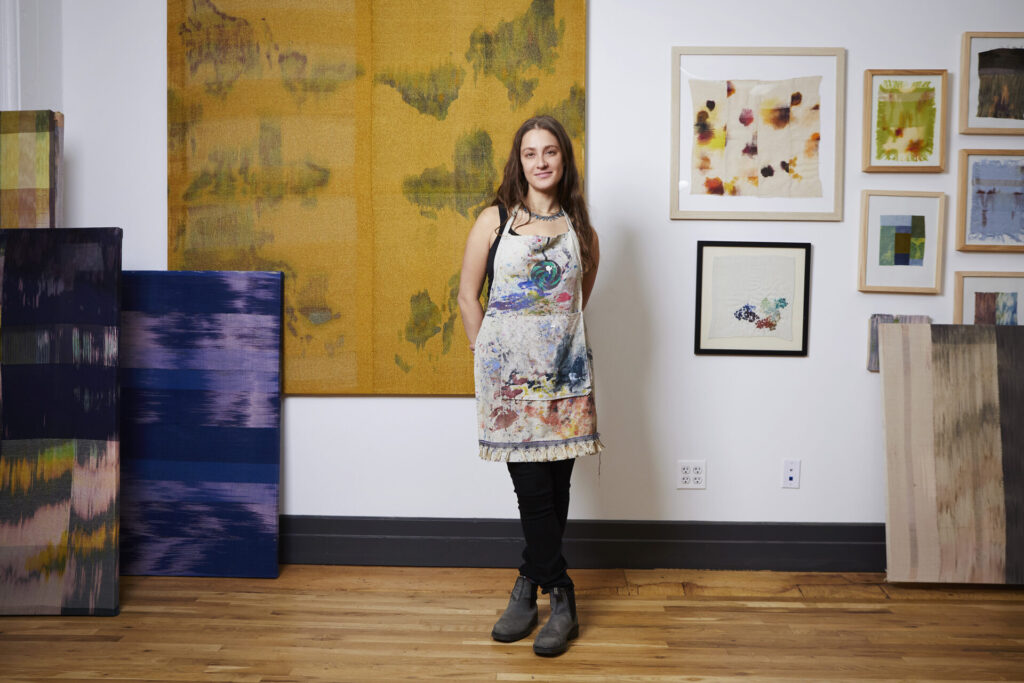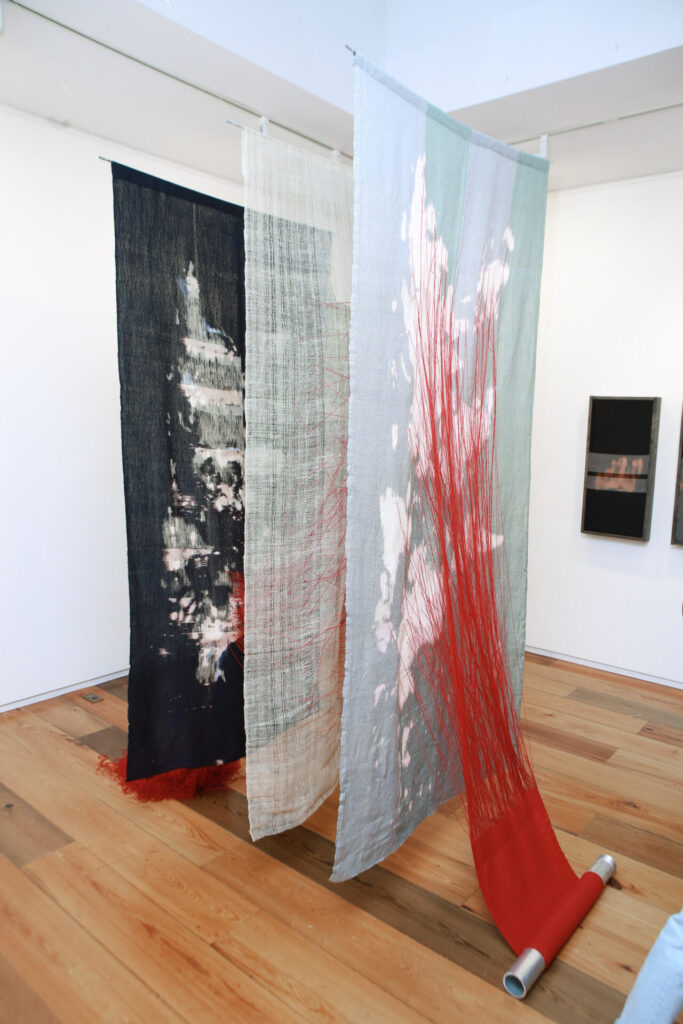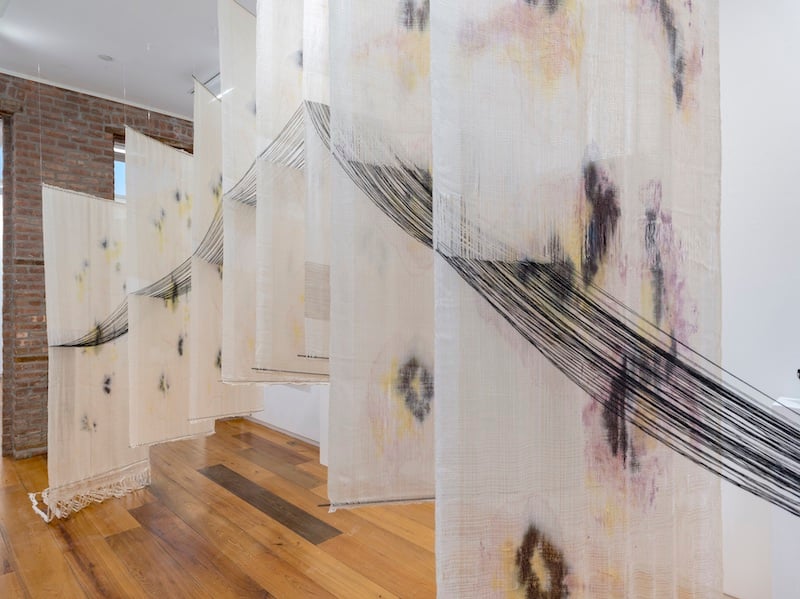In this edition of Botanical Colors’ Sunday Visit series, we sit down with Victoria Manganiello, the innovative textile artist and co-founder of Craftwork, whose work blurs the boundaries between ancient weaving traditions and cutting-edge technology. From her early days experimenting with knitting and macramé to her current projects that fuse natural dyes, fiber optics, and computer programming, Manganiello’s practice is a testament to the power of collaboration, curiosity, and storytelling. Join us as we delve into her journey—exploring how she weaves together history, materiality, and digital code to create textiles that are as poetic as they are thought-provoking.


Early Influences: What early experiences or influences led you to pursue textile art, particularly focusing on weaving and natural dyes?
I was a very busy kid—I loved making things with all kinds of materials. No one in my immediate family worked with textiles, so I’m not sure exactly where I picked it up—maybe a teacher or a friend’s parent—but somehow I learned knitting, macramé, and sewing at a very young age. Those practices really held my attention throughout childhood. I also wanted to be an architect “when I grew up,” and although I didn’t end up going down that path, I felt deeply seen when I finally read Anni Albers’ essay The Pliable Plane in college. She writes about the relationship between people drawn to textiles and those drawn to architecture, and that really resonated.
In undergrad, I had a group of incredibly inspiring professors and mentors who encouraged me to pursue art as a form of work. Classes in weaving, dyeing, and craft history helped shift what had been a childhood hobby into a real practice. Learning about natural and synthetic dyes in the context of an art class—where my brain could finally make sense of these complex systems—made me think: if I’d learned chemistry like this in middle or high school, maybe I would’ve become a scientist.
In the 13 years since finishing undergrad, I’ve continued to develop my skills in weaving and dyeing through practice and community-based skill sharing. I’m constantly influenced by the weavers and dyers around me doing such incredible work. Even though it’s been a while since I was new to this, I still feel like I’m in the early stages of my journey with these mediums. The more you learn, the more you realize just how much there is to learn.

Transition to Technology: At what point did you begin integrating technology into your textile work? What sparked this interest in combining traditional craft with modern technologies?
Textiles and technology have a long-standing shared history, and I was inspired to learn more about working with modern technology after realizing just how much of a technology weaving—albeit an ancient one—already is. I picked up basic circuitry and coding with the help of friends and community members in those fields, and, of course, through the infinite classroom that is the internet.
Collaborative projects with friends like Julian Goldman (Computer 1.0) and Petar Sapundjiev (Fermentation Quilt) helped me explore my curiosity around how and what makes a technology soft. In ongoing conversations with friends like historians and curators Sara Mills (SJSU) and Rebecca McNamara (Tang Museum), I explored the depth of shared history between cloth and communication. And I found even more inspiration—and more collaborators—in the world of e-textiles, where the creativity feels endless. It was in that community that I met my collaborator and Craftwork co-founder, Nicole Yi Messier. Together, we’ve gone on to create a range of projects, both large and small, that approach the intersection of textiles and technology from many different angles.

Your projects integrate modern technologies like fiber optics, conductive threads, and computer programming into traditional weaving techniques. How do you conceptualize the relationship between these seemingly contrasting elements?
At Craftwork, we talk a lot about the uncanny overlaps between coding and weaving. Both rely on order and repetition, loops and logic—and when one informs the other, the results can be surprisingly poetic. Weaving with a material like optical fibers—a key component of internet infrastructure and one we’ve researched extensively for “Ancient Futures”—really pushes you to consider the infinite possibilities of the woven structure.
I’m a material-based artist, and my tools and materials often guide my process intuitively. Collaborating with people from different backgrounds, and working with materials that carry different intentions, is always a surprising and inspiring part of my practice. I love working across mediums and across minds—collaboration often opens up new ways of seeing the world around us.

In your installation Computer 1.0, you explored weaving as a precursor to computational technology. How do you see the historical connection between the Jacquard loom and modern computers influencing your artistic practice?
Computer 1.0 was born out of conversations with my collaborator on that project, Julian Goldman, who has a background in industrial design. At the time, I was deeply fascinated by the historical precedent of the Jacquard Loom and was exploring ways to create soft screens or kinetic weavings. Learning more about the loom’s history opened up a broader understanding of the long-standing relationship between textiles and technology—especially the people behind that evolution.
Women—and particularly women of color—have played essential roles in the development of advanced technologies, yet their contributions are often erased from the dominant narratives. A project like Computer 1.0, which draws from the lineage of so-called “women’s work” like weaving, while simultaneously engaging with what is often labeled as “men’s work,” like tech, raises important questions about the tools and systems we use every day.
We live in a world where textiles and technology are equally ubiquitous. We all engage with both constantly, yet few people know their histories or the stories of those who have shaped them. These musings continue to inspire me to make craft as and with technology.
How do you use digital coding in your textile designs? Could you explain how these methods expand the possibilities of traditional textile art?
An ongoing series of weaving research and experimentation we’re exploring at Craftwork is called Algorithmic Textures. In this project, we use computer programming to generate patterns and weaving drafts across a range of looms—from our 12-harness Macomber to the TC2 and even industrial-scale Jacquard machines. We’re also extending this exploration into knit structures and Fair Isle colorwork through hardware and software experimentation.
It’s hard to pinpoint exactly how coding expands weaving—maybe because the relationship is more fluid than it seems. Weaving already uses its own form of code, so the two are inherently connected. But modern coding—especially with tools like the TC2—allows for faster, more experimental, and often unexpected results. Code can facilitate the generation of random or expressive shapes and textures that the human mind might not naturally arrive at, opening up new creative possibilities.

Storytelling is central to your work, from exploring women’s labor to societal disconnection from material origins. How do you weave narratives into your textile-based installations?
My woven paintings and installations rely on material and color as vehicles for storytelling. I often blend natural and synthetic materials as an entry point into conversations about the language and classifications we use in our culture. We’re taught to see things as either soft or hard, analog or digital, male or female—when in reality, binaries rarely hold up. More often, things exist on a spectrum.
I use maps and geography as starting points for the abstractions in my ikat-inspired weavings as a way to tell stories of place. And I turn to repetitive, meticulous techniques—like spinning, weaving, and dyeing—to reflect on stories of labor.

You emphasize textiles as a universal medium that connects people across cultures and histories. How does this philosophy shape your collaborative projects with other artists and educators?
Education and community organizing are central to my practice as an artist, and I find working with others to be incredibly gratifying and energizing. Textiles are familiar to all of us—not just in a subliminal way, like the fact that we wear clothes every day, but in deeply personal and sometimes imposing ways. Everywhere I go, I encounter new textile traditions—from the techniques that define nations and regions around the world to the unique practices of individuals and communities.
In undergrad, I wrote my art history thesis on how the internet has become a modern space for craft communities—reshaping how we share, learn, and make together by transcending differences. That idea feels even more true now than it did then and that research I started nearly 14 years ago has informed my practice as a maker and storyteller in big ways.
Could you discuss how your documentary on women and textiles contributes to the broader understanding of craft’s role in society?
“Women Interwoven” is a long-term project that’s slowly coming to life as an episodic collection of stories about the ways textiles—and the women who make them—shape various industries. At Craftwork, we’ve collaborated with Indigo Collective to produce “The Domestic Machine”, which will be a feature length documentary film and is currently in post-production and hopefully ready to share soon.
Working on these film projects has been an incredible opportunity to connect more deeply with the people who steward textile traditions through time and in the face of a changing world. I hope these stories invite viewers to reflect on their own personal connections to fabric and craft.

Okay for some silly questions:
What advice would you give little Victoria?
There is no such thing as the right path, you’ll make the path you choose right.
If you were a color, texture or feeling – what would it be?
Hmmm I think I’d be raw silk dyed with cochineal (maybe modified alkaline?)! A bit rough and a bit fancy haha.
The last song on your playlist?
I’ve been loving Waxahatchee recently!
Anything else you would like to tell us? What’s next for you and the Craftwork Collective?
Craftwork just finished a commission for the exhibition “Signal to Noise” at the National Communication Museum in Melbourne, AUS and we are looking forward to participating in Haystack’s MIT Labs program this summer.

